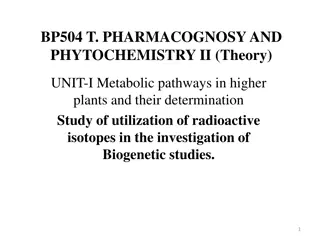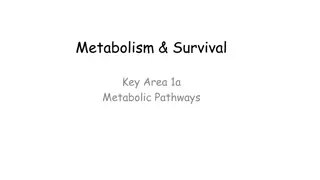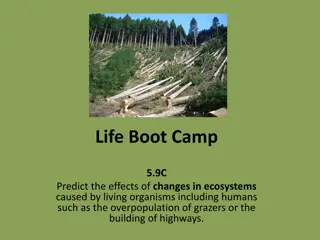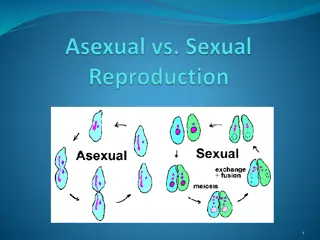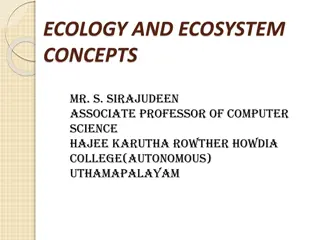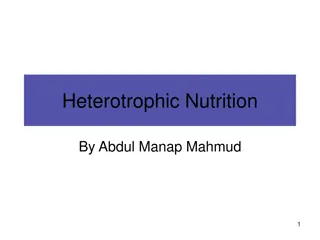Understanding Biosynthetic Pathways in Living Organisms
Biosynthesis, also known as anabolism, involves the formation of complex organic compounds from simple subunits catalyzed by enzymes within living organisms. This process is vital for the development of life and the production of essential compounds like carbohydrates, proteins, vitamins, antibiotics, and more. Primary metabolites are simple compounds, while secondary metabolites are complex and generally more limited in distribution. The metabolic pathway is a regulated series of enzyme-catalyzed reactions that occur within organisms, crucial for synthesizing and breaking down various compounds.
Download Presentation

Please find below an Image/Link to download the presentation.
The content on the website is provided AS IS for your information and personal use only. It may not be sold, licensed, or shared on other websites without obtaining consent from the author. Download presentation by click this link. If you encounter any issues during the download, it is possible that the publisher has removed the file from their server.
E N D
Presentation Transcript
UNIT-1 Biosynthetic pathway Presented by Mrs. Savula Jyothsna M. Pharm(PhD) Assoc professor Dept. Of pharmacognosy MLRIP
Biosynthesis Biosynthesis is also known as anabolism since simple compounds are joined together to form macromolecules by enzymes. Biosynthesis is a process of forming larger organic compounds from small subunits within a living organism. Biosynthesis is biological and catalyzed by enzymes. Biosynthesis occurs within a living organism. Biogenesis: Development of life from the pre-existing life
Biosynthesis: Biosynthesis is defined as building up of complex chemical compounds from simpler ones by a series of reactions catalysed by enzymes in cells, during the physiological processes of a living organism. requires precursors like ATP, NADH, NADPH, FADPH, and FADH. Generally compounds generated via biosynthesis are carbohydrates, proteins, vitamins, antibiotics, fats, alkaloids, gums etc.
By far the most important building blocks employed in the biosynthesis of secondary metabolites are derived from the intermediates acetyl coenzyme A (acetyl-CoA), shikimic acid, mevalonic acid, and 1-deoxyxylulose 5-phosphate.
S.No Primary metabolities Secondary metabolities 1 Simple in nature Complex in nature 2 They are the primary compunds Derived from primary metabolites 3 Widely distributed in nature , distributed in all organisms Generally non-expensive to produce (to isolate) and easy e.g. Starch from potato Present in plants in large quantity More limited in distribution restricted to taxonomic group Generally expensive to produce (to isolate) and difficult e.g. Quinine from Cinchona bark Present in plants in much smaller than primary metabolites They produce different product in every species They occur at stationary phase 4 5 6 They produce the same product in every species They occur at growth phase 7 8 Directly involved in growth, development and reproduction Supports the cell indirectly, thereby helps in sustaining life for longer economic importance They have marked biological or pharmacological action. e.g. Quinine antimalarial Caffiene --- CNS stimulant 9 Generally they donot have any biological or pharmacological action. e.g. Carbohydrates, Lipids, Proteins etc.
METABOLICPATHWAY It is the reaction sequence occurring within the organism is an orderly and regulated way known as metabolic pathway ( Synthesis & breakdown) It is the series of enzyme catalyzed chemical reaction which takes place inside the living organism. Metabolites A B C D Reactant Product Intermediate
ACETATEPATHWAY steroids Glycolysis Squalene Acetate mevalonate pathway Isoprenoids Pyruvate Terpenes Acetyl Co A Acetate melonate pathway Malonyl Co A TCA cycle Fatty acids Lipids ( Fats and Waxes)
ACETATE-MALONATE PATHWAY Acetate pathway operates functionally with the involvement of acyl carrier protein (ACP) to yield fatty acylthioesters of ACP. These acyl thioesters forms the important intermediates in fatty acid synthesis. These C2 acetylCoA units at the later stage produces even number of fatty acids from n-tetranoic (butyric) to n- ecosanoic (arachidic acid). Unsaturated fatty acids are produced by subsequent direct dehydrogenation of saturated fatty acids. Enzymes play important role in governing the position of newly introduced double bonds in the fatty acids.
CH3CO-S-CoA CH3COOH + CoA-SH Acetate Acetyl-CoA COOH Biotin CH3CO-S-CoA + CO2 + ATP CH2 Mn++ CO-S-CoA Malonyl-CoA
ACP- Acyl carrier protein Intermediate formed (CH2)14 (CH2)16 (CH2)16 1double bonds (CH2)16 2double bonds (CH2)16 3double bonds (CH2)16 4double bonds
BIOSYNTHESISOFTRIGLYCERIDES: It occurs in 2 stages. First stage is biosynthesis of fatty acids molecule Second stage is associated with formation of a triglyceride structure. For the formation of a fatty acid molecule, acetate is a precursor and reaction proceeds with presence of NADPH2, Mn++, ATP and two enzyme complexes (CoASH and Acetyl CoA) and Carbon dioxide. Coenzyme A (CoA) comprises of adenosine 3, 5-diphosphate, Pantothenic acid-4-phosphate and thioethanolamine. Acetyl CoA is the activated form of acetate moiety. The total reaction pathway is represented here. This reaction occurs only in the formation of saturated fatty acids. In case of unsaturated fattyacids, branched chain or other type of fatty acid, the biosynthetic pathways are not clearly known. Second stage is the formation of triglyceride structure where
BIOSYNTHESISOF GLYCOSIDES The metabolic process of glycosides formation essentially consists of two parts. The first part of biosynthesis he reaction by means of which various type of aglycones are formed. The other part of biosythesis process takes into account metabolic pathway involving coupling of aglycone with sugar moiety. 1. 2. Uridylyl transferases UTP + Sugar-1-phosphate UDP-sugar + PP1 glycosyl transferases UDP-sugar + aglycone Glycoside + UTP
Biosynthetic pathways to Flavonoid Aglycones Shikimic acid Phenylalanine Cinnamic acid Malonyl CoA ( 2 Units) + Acetyl CoA C15 intermediate Quercetin Cyanidin
Biosynthetic pathways to Flavonoid Aglycones Shikimic acid Phenylalanine Vanillin Cinnamic acid hydroquinone O-Coumaryl glycoside helicin Arbutin (phenol) Coumarin Salicin (alcohol)
BIOSYNTHESISOFEMODINANDRELATED COMPOUND 8 acetate units Poly- -ketomethylene acid intermediate Emodin and other related derivatives Biosynthesis of Cyanogenetic Glycosides Shikimic acid pathway Phenylalanine Tyrosine Valine Isoleucine Prunasin Dhurrin Linamarin Lotaustralin
AMINOACIDPATHWAY Amino acids are found in free state and as basic units of protein ( polymer of amino acids). Amino acid synthesis is the set of biochemical processes (metabolic pathways) by which the amino acids are produced. It acts as the precursor of some secondary metabolites . Most of the amino acids are -amino acids
General formula of Amino acids Amino acid pathway starts from glycolysis, Krebs cycle and -ketoglutaric acid
Nitrogen enters metabolic reacction by reductive amination +NH3 -ketoglutaric acidal Aliphatic amino acid




